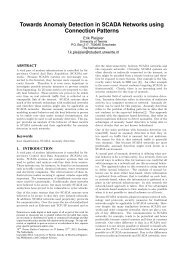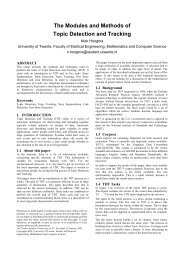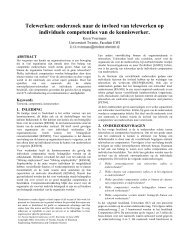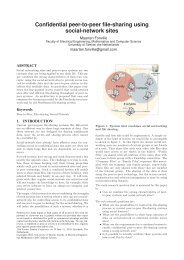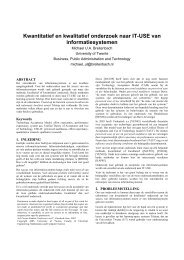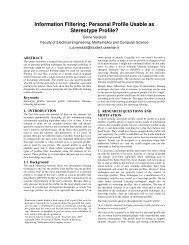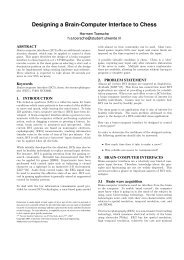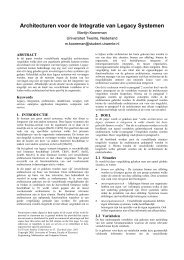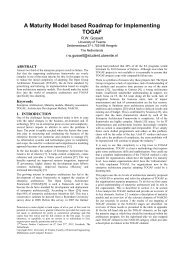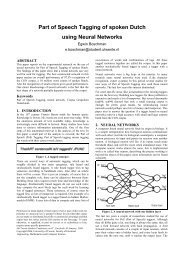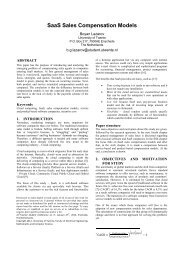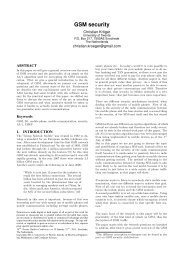s Voice to Make Human-Robot Interaction More Engaging
s Voice to Make Human-Robot Interaction More Engaging
s Voice to Make Human-Robot Interaction More Engaging
Create successful ePaper yourself
Turn your PDF publications into a flip-book with our unique Google optimized e-Paper software.
Using a <strong>Robot</strong>'s <strong>Voice</strong> <strong>to</strong> <strong>Make</strong> <strong>Human</strong>-<strong>Robot</strong> <strong>Interaction</strong><br />
<strong>More</strong> <strong>Engaging</strong><br />
Hans van de Kamp<br />
University of Twente<br />
P.O. Box 217, 7500AE Enschede<br />
The Netherlands<br />
h.vandekamp@student.utwente.nl<br />
ABSTRACT<br />
Nowadays a robot is becoming more than just a machine, the<br />
robot becomes an interaction partner. A human needs <strong>to</strong> be<br />
engaged <strong>to</strong> interact with the robot. This paper is about an<br />
experiment on robot voices in a task-based environment. The<br />
goal was <strong>to</strong> determine the influence of the robot's voice on the<br />
way humans are engaged or interested <strong>to</strong> perform a certain<br />
task. This research is contributing <strong>to</strong> the <strong>to</strong>pic of engagement<br />
in human-robot interaction with different voice styles. The<br />
participant is asked <strong>to</strong> perform six small assignments <strong>to</strong><br />
measure the effects of the different voices; a human-like voice<br />
(N=10) and a machine-like or mechanical voice (N=11).<br />
There were some significant differences between the two<br />
voices, mostly related <strong>to</strong> the likeability of the robot. The<br />
differences between the voices in terms of interest or<br />
engagement turned out <strong>to</strong> be minimal and not significant.<br />
Keywords<br />
<strong>Robot</strong> voice, challenging, engagement, human-robot<br />
interaction, task interest, robot interest<br />
1. INTRODUCTION<br />
Different frameworks for human-robot interaction have been<br />
created in the past years [1]. Most of them are trying <strong>to</strong><br />
improve human-robot interaction by incorporating human<br />
behavior and human personality traits in robots [7, 16]. <strong>Voice</strong><br />
is an important fac<strong>to</strong>r in human personality [8], therefore<br />
many robots use a human-like voice <strong>to</strong> interact with humans.<br />
Creating a human-like interaction partner has proven <strong>to</strong> be<br />
valuable in human-robot interaction [4, 10] in terms of<br />
effectiveness and efficiency [11, 15]. This research will not<br />
evaluate human-robot interaction by measuring task<br />
effectiveness or task efficiency, but it will evaluate humanrobot<br />
interaction by the way humans are engaged [12] while<br />
performing a certain assignment. This research aims <strong>to</strong><br />
provide insight on the relationship between a robot’s voice<br />
and engagement [12] in terms of interest.<br />
Permission <strong>to</strong> make digital or hard copies of all or part of this work for<br />
personal or classroom use is granted without fee provided that copies are<br />
not made or distributed for profit or commercial advantage and that<br />
copies bear this notice and the full citation on the first page. To copy<br />
otherwise, or republish, <strong>to</strong> post on servers or <strong>to</strong> redistribute <strong>to</strong> lists,<br />
requires prior specific permission and/or a fee.<br />
18 th Twente Student Conference on IT, January 25 th , 2013, Enschede, The<br />
Netherlands.<br />
Copyright 2013, University of Twente, Faculty of Electrical Engineering,<br />
Mathematics and Computer Science.<br />
1.1 Problem statement<br />
Other research [4] focuses on models in which robots mirror<br />
the participants’ behavior <strong>to</strong> create a more human-like<br />
interaction partner. However, most of that research does not<br />
focus on engaging a human. This paper focuses only on<br />
engaging a participant in human-robot interaction. <strong>Engaging</strong><br />
is related <strong>to</strong> the concept of interest as it describes attentional<br />
and emotional involvement [12]. The goal of this research is<br />
<strong>to</strong> determine the influence of a robot’s voice on the level of<br />
engagement in terms of interest [12] in human-robot<br />
interaction.<br />
It seems normal <strong>to</strong> use a more human-like robot <strong>to</strong> improve<br />
human-robot interaction, assuming that the robot is perceived<br />
as human-like. However, it is a fact that most robots are far<br />
from being like a human. If a human perceives the robot as<br />
artificial and not as human-like, it might influence the<br />
expectancy of the robot voice.<br />
If a robot is perceived as artificial and uses a mechanical voice<br />
instead of the human-like voice, does this influence the degree<br />
of which humans are engaged <strong>to</strong> perform a certain task Are<br />
humans more interested in a robot with a mechanical voice<br />
instead of a human-like voice<br />
Both questions are important <strong>to</strong> understand the relationship<br />
between humans and robots in human-robot interaction. Or in<br />
this paper more specific: the relationship between voice and<br />
engagement. With the previous questions in mind, the<br />
following research questions can be created.<br />
1.2 Research Questions<br />
To investigate the relationship between a robot’s voice and<br />
participant interest <strong>to</strong>wards the robot or task a few questions<br />
need <strong>to</strong> be answered. The main research question is:<br />
Does a robot with a humanlike voice make human-robot<br />
interaction more engaging than a mechanical voice<br />
Other research questions will be used <strong>to</strong> find an answer <strong>to</strong> the<br />
main question:<br />
- How can we find out if a person is engaged or<br />
interested in the robot or task while interacting with<br />
a robot<br />
- Does a robot’s voice influence the way participants<br />
are engaged <strong>to</strong> perform a task in terms of interest<br />
Which can be divided in<strong>to</strong> two more questions:<br />
o<br />
o<br />
Does a robot’s voice influence the way humans<br />
are interested in the robot<br />
Does a robot’s voice influence the way humans<br />
are interested in the task
2. RELATED WORK<br />
Research on human-robot interaction is often about creating a<br />
lifelike interaction partner. Therefore a lot of research is<br />
conducted with a human-like voice only, of which some are<br />
mentioned in the introduction. Important related work <strong>to</strong> this<br />
research is conducted by Walters et al. Rich and Sidner also<br />
wrote about the concept of engagement in human-robot<br />
interaction. However, they did not use different voice styles or<br />
robot appearances like Walters et al.<br />
A paper on robot appearance and personality by Walters et al.<br />
[17] investigated people’s perceptions of different robot<br />
appearances. The research uses the definitions of robot<br />
appearance based on the definitions of Gong and Nass [5] and<br />
MacDorman and Ishiguro [9]. In this experiment the robot<br />
appearances are referred <strong>to</strong> as human-like or machine-like.<br />
This paper describes the relation between interest and robot<br />
voices, it does not talk about appearance preferences in<br />
general.<br />
years with an average of 21,6 years. The second oldest<br />
participant was 24 years old.<br />
The experiment using the human voice had 10 participants<br />
and the experiment using the robot voice had 11. 20 of those<br />
participants were students of exact sciences such as Computer<br />
Science, Electrical Engineering, Mathematics or a master in<br />
the same area. The other student studied Climate &<br />
management and was apparently lost.. Because of the large<br />
amount of students with a technical background only 4<br />
participants were female. They were equally divided over<br />
both conditions.<br />
Other research by Walters et al. [18] used different robot<br />
voices similar <strong>to</strong> the experiment described in this paper.<br />
There has also been research on the gender of the robot.<br />
Siegel et al. [13] conducted research <strong>to</strong> determine the<br />
preferences of males and females on robot gender. The<br />
research showed that females generally did not have a<br />
preference of robot gender. However, males seem <strong>to</strong> have a<br />
preference of a female robot gender.<br />
Research performed by Crowell et al. [3] indicate that the<br />
perceived gender of the robot may influence human sexrelated<br />
characteristics.<br />
3. METHODOLOGY<br />
In this experiment the Magabot robot is used. A pho<strong>to</strong> of the<br />
robot is shown in the figure at the right. The robot is small<br />
(less than 1 meter tall) and offers a platform on which a lap<strong>to</strong>p<br />
can be placed.<br />
The robot will be controlled using a Wizard of Oz technique<br />
because of communication problems between the robot and<br />
Flash. The robot will drive on a platform between two tables,<br />
which will be explained in section 3.3. The voice and eyes are<br />
programmed in Flash (ActionScript). The robot used a<br />
predefined script in the form of a Flash timeline. The timeline<br />
was divided in<strong>to</strong> several segments <strong>to</strong> allow a researcher <strong>to</strong><br />
control the robot's script.<br />
As seen in the figure at the right, the lap<strong>to</strong>p displayed the<br />
robot's eyes. The robot eyes and effects such as blinking were<br />
used <strong>to</strong> make the robot more life-like. In the experiment the<br />
robot eyes were used <strong>to</strong> look at objects.<br />
Based on the research conducted by Siegel et al. [13], the<br />
robot had a female voice. Both the human-like and machinelike<br />
voice were female (or female-like) voices. The used<br />
voices are discussed in section 3.2. The robot itself had no<br />
gender. The gender was determined by the voice of the robot.<br />
The robot introduced herself as Jane.<br />
3.1 Participants<br />
A <strong>to</strong>tal of 21 participants <strong>to</strong>ok part in the experiment using a<br />
between subjects design. Their age varied between 19 and 31<br />
Figure 1: the Magabot with lap<strong>to</strong>p and eyes used in the<br />
experiment.<br />
3.2 <strong>Voice</strong><br />
Two different female voices were used in the experiment. The<br />
robot used a predefined script (in English) <strong>to</strong> communicate<br />
with the participants. Both voices were created with the<br />
MARY Text-<strong>to</strong>-Speech system. The first group of participants<br />
(N=10) interacted with a robot using a synthesized human-like<br />
female voice. The second group of participants (N=11)<br />
interacted with a robot using a synthesized machine-like or<br />
mechanical-like female voice. The used voice was in MARY<br />
called 'cmu-slt-hsmm'. The second group had a robot filter <strong>to</strong><br />
create a more machine-like or mechanical voice.<br />
3.3 Experiment Setup<br />
The conducted experiment was combined with research about<br />
proxemics in human-robot interaction, or more specific the<br />
relationship between a robot's voice and proxemics. The<br />
experiment was divided in three parts.<br />
In the first part the robot tells its name and asks the participant<br />
<strong>to</strong> come closer. This part was needed for the other experiment<br />
and is also a good introduction of the robot. The participant<br />
walks <strong>to</strong>wards the robot and the robot then tells the participant<br />
<strong>to</strong> do some simple tasks. The participant is asked <strong>to</strong> take a seat
at the table. The robot drives <strong>to</strong> the other side of the table,<br />
making sure the participant is sitting opposite of the robot.<br />
For the second part of the experiment, the participant<br />
performs six simple assignments. On the table are six cards<br />
with letters forming the word ‘thanks’ and also six (empty)<br />
numbered boxes. Three of the cards are faced up and show the<br />
letter, the others show the backside which is colored (red,<br />
green and blue). The six assignments are small assignments<br />
such as ‘move the letter N <strong>to</strong> box 2’, ‘swap the letter N with<br />
the letter H’ or ‘please turn over all colored squares’. The start<br />
of each of the assignments was triggered by hand using a<br />
Wizard of Oz technique. After some assignments the<br />
participant tells the robot how many boxes are left empty <strong>to</strong><br />
enforce interaction with the robot. After moving all cards the<br />
robot asks the participant <strong>to</strong> flip all colored cards and read the<br />
word in the boxes. The robot then thanks the participant and<br />
drives <strong>to</strong> the table on the left-hand side of the participant.<br />
The third part of the experiment is very small. When the robot<br />
arrives at the table it turns around and asks the participant <strong>to</strong><br />
come closer. This part is also needed for the other experiment.<br />
The robot tells the participant there is a questionnaire on the<br />
table next <strong>to</strong> her and asks the participant <strong>to</strong> fill it in. The<br />
experiment has ended.<br />
The figure below shows a picture taken from the experiment<br />
setup. The table with the six squares is in front of a platform<br />
on which the robot drives around. This was necessary because<br />
otherwise the robot was <strong>to</strong>o small and the participant would<br />
not have been able <strong>to</strong> see the robot’s eyes.<br />
The moving assignments are similar <strong>to</strong> the ones used by<br />
Staudte et al. [14]. However this experiment is not based on<br />
utterance or gesture, but instead focuses on the two different<br />
voices.<br />
Figure 2: the experiment setup.<br />
3.4 Questionnaire & video footage<br />
A three-page questionnaire was used <strong>to</strong> determine if a person<br />
was engaged or interested in the robot or task. The<br />
questionnaire is based on measurement instruments for<br />
measuring anthropomorphism, animacy, likeability, perceived<br />
intelligence and perceived safety of robots provided by<br />
Bartneck et al. [2] <strong>to</strong> get understanding of how the robot was<br />
perceived by the participants. The questionnaire also contains<br />
questions on the attention allocation scale provided by Harms<br />
and Biocca [6] <strong>to</strong> find out if the participants were interested in<br />
the robot or the task.<br />
The questionnaire consists of five parts. The first part is about<br />
some general information. The second, third and fifth part<br />
contains 32 questions about the experiment on a 5-point<br />
Likert scale provided by Bartneck et al. [2]. The fourth part<br />
contains 9 questions which are rated on a scale from 1 <strong>to</strong> 7, of<br />
which some are provided by Harms and Biocca [6]. Because<br />
the conducted experiment is shared with Rens Hoegen not all<br />
questions will be used for providing answers in this paper.<br />
3.4.1 Most important questions<br />
The categories ‘rating of the participant’s’ have some<br />
important questions in order <strong>to</strong> answer the research questions:<br />
- artificial / lifelike & mechanical / Organic:<br />
questions in the categories anthropomorphism and<br />
animacy <strong>to</strong> determine how the robot's appearance<br />
was perceived.<br />
- unfriendly / friendly & unpleasant / pleasant:<br />
questions in the category likeability <strong>to</strong> rate the<br />
impression of the robot.<br />
- incompetent / competent & unintelligent /<br />
intelligent: questions in the category perceived<br />
intelligence.<br />
Another category contains questions <strong>to</strong> which the participant<br />
can disagree or agree. The most important are:<br />
- I was interested in the robot.<br />
- I was interested in the task.<br />
- I remained focused on the robot throughout our<br />
interaction.<br />
- I remained focused on the task throughout our<br />
interaction.<br />
The questionnaire ends with a manipulation check <strong>to</strong><br />
determine if the difference in voices was noticed. The<br />
experiment was also recorded by two different cameras (one<br />
full HD camcorder and one fisheye camera) in order <strong>to</strong><br />
support the questionnaire. Some small screenshots taken from<br />
the video footage can be found in section 4.2. The questions<br />
of the questionnaire can be found in Appendix A.<br />
4. RESULTS<br />
Most of the 41 questions from the questionnaire were used <strong>to</strong><br />
analyze the relationship between voices and the level of<br />
interest. Some questions were not relevant for this research<br />
because it was a combined experiment. At first it is important<br />
<strong>to</strong> determine the reliability of the questions, after that the<br />
questions will be used <strong>to</strong> answer the research questions.<br />
Finally some screenshots of the video footage is shown <strong>to</strong><br />
highlight some details.<br />
Figure 3: a schematic representation of the experiment.
4.1 Questionnaire<br />
The categories anthropomorphism, animacy, likeability,<br />
perceived intelligence and perceived safety suggested by<br />
Bartneck et al. [2] were all used in the questionnaire.<br />
4.1.1 Reliability<br />
The Cronbach Alpha value of each of the categories is listed<br />
in the third column of the table below. The second column<br />
shows which questions were used in that particularly<br />
category. The matching questions can be found in Appendix<br />
A.<br />
Table 1: Cronbach Alpha values for each category before<br />
removing questions.<br />
Category Questions (#) Cronbach Alpha<br />
Anthropomorphism 1, 5, 9, 13, 17 0.62<br />
Animacy 2, 6, 10, 13, 14,<br />
18<br />
0.62<br />
Likeability 3, 7, 11, 15, 19 0.81<br />
Perc. intelligence 4, 8, 12, 16, 20 0.61<br />
Perc. safety 24, 25, 26 0.67<br />
Because most Cronbach Alpha values were not very reliable<br />
some questions have been deleted. To achieve a Cronbach<br />
Alpha value of at least 0.70 in each category the following<br />
questions have been deleted:<br />
- moving rigidly / moving elegantly & unconscious /<br />
conscious in the category anthropomorphism.<br />
- apathetic / responsive, stagnant / lively & inert /<br />
interactive in the category animacy.<br />
- foolish / sensible in the category perceived<br />
intelligence.<br />
- quiescent / surprised in the category perceived<br />
safety.<br />
It is important <strong>to</strong> state that some participants had trouble with<br />
the meaning of apathetic and quiescent, all participants were<br />
Dutch.<br />
This results in the following Cronbach Alpha values:<br />
Table 2: Cronbach Alpha values for each category after<br />
removing questions.<br />
Category Questions (#) Cronbach Alpha<br />
Anthropomorphism 1, 5, 13 0.78<br />
Animacy 2, 10, 13 0.72<br />
Likeability 3, 7, 11, 15, 19 0.81<br />
Perc. intelligence 4, 8, 12, 16 0.72<br />
Perc. safety 24, 25 0.85<br />
4.1.2 Analysis<br />
In the tables below the results of the Independent Samples T-<br />
tests is shown. In table 3 the results of the test are shown for<br />
Bartneck’s categories. The results of the questions used in the<br />
manipulation check are shown in table 4.<br />
The other questions, including the questions taken from<br />
Harms and Biocca are evaluated separately in tables 5 and 6.<br />
Table 3: Independent Samples T-tests results for<br />
Bartneck’s categories with both conditions.<br />
Category <strong>Voice</strong> M SD t(19) p<br />
Anthropomorphism<br />
Animacy<br />
Likeability<br />
Perceived<br />
intelligence<br />
Perceived<br />
safety<br />
<strong>Human</strong>-like 2.47 0.48<br />
Machine-like 1.97 0.64<br />
<strong>Human</strong>-like 2.23 0.61<br />
Machine-like 2.03 0.71<br />
<strong>Human</strong>-like 4.00 0.46<br />
Machine-like 3.51 0.47<br />
<strong>Human</strong>-like 3.48 0.38<br />
Machine-like 3.20 0.65<br />
<strong>Human</strong>-like 3.75 0.83<br />
Machine-like 3.86 0.60<br />
2.00 0.060<br />
0.70 0.491<br />
2.42 0.026<br />
1.15 0.266<br />
-0.37 0.719<br />
Analyzing and comparing the two tables above shows that the<br />
categories animacy, perceived intelligence and perceived<br />
safety have no significant difference between the human-like<br />
voice and the machine-like voice. The category likeability on<br />
the contrary does show a significant difference between the<br />
human-like voice and the machine-like voice. The category<br />
anthropomorphism was approaching significance.<br />
Table 4: Independent Samples T-tests results for the<br />
manipulation check with both conditions.<br />
Question <strong>Voice</strong> M SD T(19) p<br />
Machinelike<br />
/ <strong>Human</strong>like<br />
Unpleasant<br />
/ Pleasant<br />
Disengaging<br />
/ <strong>Engaging</strong><br />
Unclear<br />
/ Clear<br />
<strong>Human</strong>-like 2.00 1.05<br />
Machine-like 1.64 0.51<br />
<strong>Human</strong>-like 3.20 0.92<br />
Machine-like 3.00 0.78<br />
<strong>Human</strong>-like 2.90 0.57<br />
Machine-like 3.09 0.70<br />
<strong>Human</strong>-like 3.20 0.92<br />
Machine-like 2.36 0.67<br />
1.02 0.319<br />
0.54 0.595<br />
-0.68 0.504<br />
2.39 0.027<br />
The questions machinelike / humanlike, unpleasant / pleasant<br />
& disengaging / engaging in the manipulation check about the<br />
voice only showed minor differences, mostly in favor of the<br />
human-like model. The most important significant difference<br />
can be found in the question unclear / clear. It showed that the<br />
human-like voice was more clear than the machine-like voice<br />
and that a difference in voices was noticed. This can also be<br />
seen in the video footage, discussed in section 4.2 below.<br />
Some 7-point scale questions are excluded in this research, the<br />
others are listed below in tables 5 and 6. For each of the<br />
questions the Independent Samples T-test is performed and<br />
listed below.<br />
Table 5: Independent Samples T-tests results for the<br />
remaining questions with the human-like voice.<br />
Question<br />
M SD t(19) p<br />
I feel that the robot is interesting <strong>to</strong> look at.<br />
4.80 1.03 1.65 0.115
I was interested in the robot.<br />
5.70 0.48 1.13 0.273<br />
I was interested in the task.<br />
4.70 1.57 0.48 0.636<br />
I was easily distracted from the robot when other things were<br />
going on. (Recoded)<br />
5.40 1.17 1.11 0.281<br />
I remained focused on the robot throughout our interaction.<br />
4.90 1.52 -0.95 0.352<br />
I remained focused on the task throughout our interaction.<br />
5.10 1.20 -1.66 0.112<br />
Understanding the robot was difficult. (Recoded *)<br />
5.50 1.18 1.86 0.078<br />
voices. These pictures will be used in section 6 <strong>to</strong> support the<br />
conclusion.<br />
Figure 3: the participant is fixating on the robot after<br />
completing an assignment.<br />
Table 6: Independent Samples T-tests results for the<br />
remaining questions with the machine-like voice.<br />
Question<br />
M SD t(19) p<br />
I feel that the robot is interesting <strong>to</strong> look at.<br />
3.82 1.601 1.65 0.115<br />
I was interested in the robot.<br />
5.27 1.104 1.13 0.273<br />
I was interested in the task.<br />
4.36 1.629 0.48 0.636<br />
I was easily distracted from the robot when other things were<br />
going on. (Recoded)<br />
4.73 1.555 1.11 0.281<br />
I remained focused on the robot throughout our interaction.<br />
5.45 1.128 -0.95 0.352<br />
I remained focused on the task throughout our interaction.<br />
5.82 0.751 -1.66 0.112<br />
Understanding the robot was difficult. (Recoded *)<br />
4.36 1.567 1.86 0.078<br />
Figure 4: her facial expressions indicate that she has<br />
difficulties with understanding the robot.<br />
The above tables show that the differences between the two<br />
voices in terms of interest is not very significant. Thought it is<br />
interesting <strong>to</strong> know that there is a slight difference in focusing<br />
on either the task or the robot.<br />
* Note that some questions are recoded <strong>to</strong> make sure that all<br />
questions are rated the same way, meaning that 1 = negative,<br />
4 = neutral and 7 = positive. In the question ‘Understanding<br />
the robot was difficult.’ 1 was positive (not difficult) and 7<br />
was negative (difficult), therefore the question is recoded <strong>to</strong><br />
match its rating with the other questions.<br />
4.2 Video footage<br />
In the previous section it became clear that the human-like<br />
voice was more likeable and that understanding the robot was<br />
slightly more difficult with the machine-like voice. The<br />
machine-like voice was rated as more unclear compared <strong>to</strong> the<br />
human-like voice. The video footage showed the exact same<br />
results. The pictures below show some information about the<br />
Figure 5: the participant is staring at the background,<br />
thinking about what the robot just said.<br />
5. DISCUSSION<br />
The difference between the two used voices turned out <strong>to</strong> be<br />
not very significant. The most important differences were<br />
found in Bartneck's category likeability and the question<br />
unclear / clear in the manipulation check. The human-like<br />
voice scored higher on the likeability scale and was found<br />
more clear than the machine-like voice. The questions in the<br />
category anthropomorphism were only approaching<br />
significance and showed that the human-like voice was<br />
perceived as slightly more anthropomorphic. There was also a<br />
minor difference in understanding the robot. The machine-like<br />
voice was harder <strong>to</strong> understand than the human-like voice,<br />
which relates <strong>to</strong> the difference found in the unclear / clear<br />
question.
The relationship between voice and interest is not significant.<br />
In the introduction the question 'If a robot is perceived as<br />
artificial and uses a mechanical voice instead of the usual<br />
human-like voice, does this influence the way humans are<br />
engaged <strong>to</strong> perform a certain task' came <strong>to</strong> mind. The results<br />
show that the influence of the voices is minimal. The robot<br />
with the human-like voice was perceived only a little more<br />
interesting.<br />
The results in table 5 and 6 appear <strong>to</strong> show a contradiction.<br />
The human-model scored slightly better on the questions<br />
about interest. However, the questions about focus show a<br />
minor difference in favor of the machine-like voice.<br />
6. CONCLUSION<br />
As mentioned above, some results appear <strong>to</strong> be contradicting.<br />
Though these results are not as significant as hoped, the<br />
difference can still be explained. Because the machine-like<br />
voice was rated less clear than the human-like voice, some<br />
participants had difficulties with understanding the robot.<br />
Section 4.2 shows three pictures taken from the video footage.<br />
Figure 4 shows a participant with facial expressions indicating<br />
it takes some effort <strong>to</strong> understand the robot. Figure 5 shows a<br />
participant thinking about what the robot said. It seems that<br />
the participants with the machine-like voice focused more on<br />
the robot because of the unclear voice.<br />
With the above results, the research questions mentioned in<br />
section 1.2 can be answered:<br />
This research showed that a robot's voice does not<br />
significantly influence the way participants are engaged <strong>to</strong><br />
perform a certain task. Nor were the participants significantly<br />
more interested in the robot or task.<br />
The human-like voice in general scored overall better than the<br />
machine-like voice. This result is similar <strong>to</strong> the results found<br />
by other researchers mentioned in the introduction.<br />
7. FUTURE WORK<br />
In order <strong>to</strong> completely understand the relationship between<br />
voice and engagement, more research needs <strong>to</strong> be conducted.<br />
To improve this research better utilities are necessary. The<br />
used Magabot did not have a body (or body movement) and<br />
lacked facial expressions. To improve this experiment some<br />
aspects of the robot such as embodiment and perceived gender<br />
(more than just the voice of the robot) should be implemented.<br />
The robot was not quite socially interactive.<br />
The video footage could have been of greater importance <strong>to</strong><br />
this research. Due <strong>to</strong> time issues, it was only possible <strong>to</strong> use<br />
the video footage as support <strong>to</strong> the questionnaire. The analysis<br />
of the video footage might reveal more interesting facts in a<br />
larger study.<br />
Some participants asked how the robot knew they were<br />
finished with a certain task. Parts of the experiment were<br />
conducted using the Wizard of Oz technique, which might<br />
have influenced the way the participant perceived the robot. In<br />
the future it is necessary <strong>to</strong> create a robot which responds<br />
au<strong>to</strong>nomous based on the actions of the participant.<br />
Future work on this research might use a larger group of<br />
participants with equally mixed gender and a less technical<br />
background. The experiment was also conducted in a taskbased<br />
environment, experimenting in a more real-life situation<br />
would be more appropriate.<br />
8. ACKNOWLEDGEMENTS<br />
I would like <strong>to</strong> thank Betsy van Dijk and Manja Lohse for<br />
providing guidance and solving problems during the research.<br />
And I would also like <strong>to</strong> thank the University of Twente for<br />
providing all necessary utilities <strong>to</strong> conduct the experiments.<br />
My thanks also go <strong>to</strong> Gilber<strong>to</strong> Sepúlveda Bradford and Rens<br />
Hoegen for helping with the robot and the experiments.<br />
9. REFERENCES<br />
[1] C. Bartneck and J. Forlizzi. A Design-Centred<br />
Framework for Social <strong>Human</strong>-<strong>Robot</strong> <strong>Interaction</strong>. In<br />
Proceedings of the Ro-Man2004, Kurashiki pp. 591-594.<br />
2004. ACM.<br />
DOI: http://dx.doi.org/10.1109/ROMAN.2004.1374827<br />
[2] C. Bartneck, D. Kulić, E. Croft and S. Zoghbi.<br />
Measurement Instruments for the Anthropomorphism,<br />
Animacy, Likeability, Perceived Intelligence, and<br />
Perceived Safety of <strong>Robot</strong>s. In International Journal of<br />
Social <strong>Robot</strong>ics, Vol 1(1), 71-81. 2009.<br />
DOI=http://dx.doi.org/10.1007/s12369-008-0001-3<br />
[3] C.R. Crowelly, M. Villanoy, M. Scheutz and P.<br />
Schermerhorn. Gendered voice and robot entities:<br />
Perceptions and reactions of male and female subjects. In<br />
Intelligent <strong>Robot</strong>s and Systems, IROS 2009, IEEE/RSJ<br />
International Conference, 3735-3741. 2009.<br />
DOI=http://dx.doi.org/10.1109/IROS.2009.5354204<br />
[4] J. Goetz, S. Kiesler, and A. Powers. Matching robot<br />
appearance and behavior <strong>to</strong> tasks <strong>to</strong> improve humanrobot<br />
cooperation. In Proceedings of ROMAN 2003, the<br />
12th IEEE International Workshop on <strong>Robot</strong> and <strong>Human</strong><br />
Interactive Communication, 55-60, 2003. ACM.<br />
DOI= http://dx.doi.org/10.1109/ROMAN.2003.1251796<br />
[5] L. Gong and C. Nass. When a talking-face computer<br />
agent is half-human and half-humanoid: human identity<br />
and consistency preference. In Journal of <strong>Human</strong><br />
Communication Research, Vol 33(2), 163–193. 2007.<br />
DOI=http://dx.doi.org/10.1111/j.1468-958.2007.00295.x<br />
[6] C. Harms and F. A.Biocca. Internal consistency and<br />
reliability of the networked minds social presence<br />
measure. In M. Alcaniz & B. Rey (Eds.), Seventh Annual<br />
International Workshop. 2004. ACM.<br />
DOI=http://cogprints.org/7026/<br />
[7] K. M. Lee, W. Peng, S. Jin and C. Yan. Can robots<br />
manifest personality An empirical test of personality<br />
recognition, social responses, and social presence in<br />
human-robot interaction. In Journal of Communication,<br />
56, 754-772. 2006.<br />
DOI=http://dx.doi.org/10.1111/j.1460-466.2006.00318.x<br />
[8] J. A. LePine and L. Van Dyne. <strong>Voice</strong> and cooperative<br />
behavior as contrasting forms of contextual performance:<br />
Evidence of differential relationships with Big Five<br />
personality characteristics and cognitive ability. In<br />
Journal of Applied Psychology, Vol 86(2), 326-336.<br />
2001.<br />
DOI=http://psycnet.apa.org/doi/10.1037/0021-<br />
9010.86.2.326<br />
[9] K. MacDorman and H. Ishiguro. The uncanny advantage<br />
of using androids in cognitive and social science<br />
research. <strong>Interaction</strong> Studies, Vol 7(3), 297–337. 2006.<br />
DOI=http://dx.doi.org/10.1075/is.7.3.03mac
[10] B. Mutlu, J. Forlizzi and J. Hodgins. A S<strong>to</strong>rytelling<br />
<strong>Robot</strong>: Modeling and Evaluation of <strong>Human</strong>-like Gaze<br />
Behavior. In Proceedings of HUMANOIDS’06, 2006.<br />
ACM.<br />
DOI= http://dx.doi.org/10.1109/ICHR.2006.321322<br />
[11] Y. Okuno, T. Kanda, M. Imai, H. Ishiguro, and N.<br />
Hagita. Providing route directions: design of robot’s<br />
utterance, gesture, and timing. In Proceedings of the 4th<br />
ACM/IEEE international conference on <strong>Human</strong> robot<br />
interaction, HRI’09, 53-60, 2009. ACM.<br />
DOI=http://doi.acm.org/10.1145/1514095.1514108<br />
[12] C. Peters, G. Castellano and S. de Freitas. An exploration<br />
of user engagement in HCI. In Proceedings of the<br />
affective-aware virtual agents and social robots<br />
(AFFINE) workshop, international conference on<br />
multimodal interfaces, ICMI’09, 2009. ACM.<br />
DOI=http://doi.acm.org/10.1145/1655260.1655269<br />
[13] M. Siegel, C. Breazeal and M. I. Nor<strong>to</strong>n. Persuasive<br />
<strong>Robot</strong>ics: The influence of robot gender on human<br />
behavior. In Intelligent <strong>Robot</strong>s and Systems, IROS<br />
(2009). 2563-2568. 2009. ACM.<br />
DOI=http://dx.doi.org/10.1109/IROS.2009.5354116<br />
[14] M. Staudte and M. Crocker. Visual attention in spoken<br />
human-robot interaction. In Proceedings of the 4th<br />
ACM/IEEE international conference on <strong>Human</strong> robot<br />
interaction, HRI’09, 77–84, 2009. ACM.<br />
DOI=http://doi.acm.org/10.1145/1514095.1514111<br />
[15] A. Steinfeld, T. Fong, D. Kaber, M. Lewis, J. Scholtz, A.<br />
Schultz and M. Goodrich. Common metrics for humanrobot<br />
interaction. In Proceedings of the 1st ACM/IEEE<br />
International Conference on <strong>Human</strong><strong>Robot</strong> <strong>Interaction</strong>s,<br />
HRI'06, 2006. ACM.<br />
DOI= http://dx.doi.org/10.1145/1121241.1121249<br />
[16] M. L. Walters, K. Dautenhahn, R. te Boekhorst, K. L.<br />
Koay, C. Kaouri, S. Woods, C. Nehaniv, D. Lee, and I.<br />
Werry. The influence of subjects’ personality traits on<br />
personal spatial zones in a human-robot interaction<br />
experiment. In Proceedings of COG SCI 2005: Toward<br />
Social Mechanisms of Android Science Workshop, 29-37,<br />
2005. ACM.<br />
DOI= http://dx.doi.org/10.1109/ROMAN.2005.1513803<br />
[17] M. L. Walters, D. S. Syrdal, K. Dautenhahn, R. te<br />
Boekhorst and K. L. Koay. Avoiding the uncanny valley:<br />
robot appearance, personality and consistency of<br />
behavior in an attention-seeking home scenario for a<br />
robot companion. Au<strong>to</strong>nomous <strong>Robot</strong>s, 159-178. 2008.<br />
DOI=http://dx.doi.org/10.1007/s10514-007-9058-3<br />
[18] M. L. Walters, D. S. Syrdal, K. L. Koay, K. Dautenhahn,<br />
R. te Boekhorst. <strong>Human</strong> approach distances <strong>to</strong> a<br />
mechanical-looking robot with different robot voice<br />
styles. In the 17th IEEE International Symposium on<br />
<strong>Robot</strong> and <strong>Human</strong> Interactive Communication, RO-<br />
MAN (2008), 707-712. 2008.<br />
DOI=http://dx.doi.org/10.1109/ROMAN.2008.4600750
APPENDIX<br />
A. RESULTS QUESTIONNAIRE<br />
Table A1: first part of the questionnaire containing questions rated on a scale from 1 <strong>to</strong> 5.<br />
<strong>Human</strong>-like voice<br />
Machine-like voice<br />
# Questions Mean Std. Deviation Mean Std. Deviation<br />
Rate the impression of the robot on a scale from 1 <strong>to</strong> 5.<br />
1 Fake / Natural 3.20 0.632 2.45 0.820<br />
2 Dead / Alive 2.90 1.101 2.55 1.036<br />
3 Dislike / Like 4.00 0.667 3.27 0.647<br />
4 Incompetent / Competent 3.50 0.850 3.55 0.934<br />
5 Machinelike / <strong>Human</strong>like 1.90 0.738 1.64 0.674<br />
6 Stagnant / Lively 3.10 1.370 2.45 0.820<br />
7 Unfriendly / Friendly 4.30 0.675 3.73 0.467<br />
8 Ignorant / Knowledgeable 3.40 0.699 3.09 0.701<br />
9 Unconscious / Conscious 3.10 0.876 2.82 0.874<br />
10 Mechanical / Organic 1.50 0.707 1.73 0.647<br />
11 Unkind / Kind 4.10 0.738 3.55 0.522<br />
12 Irresponsible / Responsible 3.40 0.516 3.00 0.632<br />
13 Artificial / Lifelike 2.30 0.483 1.82 0.751<br />
14 Inert / Interactive 3.60 0.699 3.09 0.831<br />
15 Unpleasant / Pleasant 3.70 0.675 3.45 0.688<br />
16 Unintelligent / Intelligent 3.60 0.516 3.18 0.874<br />
17 Moving rigidly / Moving elegantly 2.80 0.919 2.27 1.009<br />
18 Apathetic / Responsive 3.50 0.850 3.36 0.674<br />
19 Awful / Nice 3.90 0.738 3.55 0.688<br />
20 Foolish / Sensible 3.00 0.471 3.55 0.688<br />
21 Quiet / Loud 2.60 0.699 2.64 0.674<br />
22 Unhelpful / Helpful 3.50 0.527 3.45 0.820<br />
23 Intimidating / Inviting 3.60 0.699 3.55 0.820<br />
Rate your emotional state on a scale from 1 <strong>to</strong> 5.<br />
24 Anxious / Relaxed 3.70 0.949 3.91 0.539<br />
25 Agitated / Calm 3.80 0.789 3.82 0.751<br />
26 Quiescent / Surprised 2.50 0.850 3.00 0.894<br />
27 Unsafe / Safe 4.00 1.054 4.27 0.647<br />
28 Pressured / At ease 3.70 0.823 3.45 0.688
Table A2: second part of the questionnaire containing questions rated on a scale from 1 <strong>to</strong> 7.<br />
<strong>Human</strong>-like voice<br />
Machine-like voice<br />
# Questions Mean Std. Deviation Mean Std. Deviation<br />
Give your opinion on the following statements. (Scale from 1 <strong>to</strong> 7, strongly disagree <strong>to</strong> strongly agree.)<br />
29 I feel that the robot is interesting <strong>to</strong> look at. 4.80 1.033 3.82 1.601<br />
30 I was interested in the robot. 5.70 0.483 5.27 1.104<br />
31 I was interested in the task. 4.70 1.567 4.36 1.629<br />
32 I was easily distracted from the robot when other things<br />
were going on.<br />
33 I remained focused on the robot throughout our<br />
interaction.<br />
34 I remained focused on the task throughout our<br />
interaction.<br />
5.40 1.174 4.73 1.555<br />
4.90 1.524 5.45 1.128<br />
5.10 1.197 5.82 0.751<br />
35 Understanding the robot was difficult. 5.50 1.179 4.36 1.567<br />
36 Throughout our interaction I became more familiar with<br />
the robot.<br />
5.20 0.919 4.45 1.508<br />
37 I felt uncomfortable when I was close <strong>to</strong> the robot. 5.30 0.949 5.55 1.695<br />
Table A3: third part of the questionnaire containing questions rated on a scale from 1 <strong>to</strong> 5, used as the manipulation check.<br />
<strong>Human</strong>-like voice<br />
Machine-like voice<br />
# Questions Mean Std. Deviation Mean Std. Deviation<br />
Rate your impression of the voice of the robot on the following scales.<br />
38 Machinelike / <strong>Human</strong>like 2.00 1.054 1.64 0.505<br />
39 Unpleasant / Pleasant 3.20 0.919 3.00 0.775<br />
40 Disengaging / <strong>Engaging</strong> 2.90 0.568 3.09 0.701<br />
41 Unclear / Clear 3.20 0.919 2.36 0.674



